260. 6 October 2004:
More Burn-moves
Burn's fantastic move Qg4 (item 258) continues to fascinate readers. See the PS to that item, and two comparable sacrifices, be it not of a Queen.
Dennis Monokroussos came across this game:
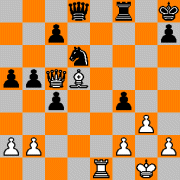 Karagianis - Anka, National Open, Las Vegas 2004
Karagianis - Anka, National Open, Las Vegas 2004
1.d4 Nf6 2.Nf3 e6 3.c4 Bb4+ 4.Bd2 Qe7 5.g3 Nc6 6.Bg2 Bxd2+ 7.Nbxd2 d6 8.
O-O e5 9.d5 Nb8 10.e4 a5 11.c5 dxc5 12.Nc4 O-O 13.Ncxe5 Nxe4 14.Re1 f5
15.Nd3 c4 16.Nf4 g5 17.Ne6 Bxe6 18.dxe6 Nc6 19.Qd5 Rae8 20.Nd4 Nxd4 21.
Qxd4 Nd6 22.Bd5 Rd8 23.Qc5 b6 24.Qc6 f4 25.Re5 Kh8 26.Rae1 b5 27.Qc5 Kg8
28.Rxg5+ Qxg5 29.e7+ Kh8 30.exd8Q Qxd8 (see diagram)
It must have been good enough in itself for 2098-rated Kargianis to beat a grandmaster, but the way he did it was brilliant: 31.Re8 An unguarded Rook move to a square attacked by three enemy pieces. Black resigned - or did he overstep the time? Because a resignation might have been in shock; as Monokroussos remarks, the beautiful two-diagonal mate is not forced, and after 31...Qf6 32.Rxf8+ Qxf8 33.Qxc7 White is hardly better.
PS 8 October: In a mail to New in Chess' René Olthof who asked him, Emil Anka acknowledged that the 1-0 was a real resignation: "I just resigned (...) because of the shock, and because of the fact - shame on me! - that I did not see 32.Rxf8+ Qxf8 33.Qd4+ Qg7. That was the first - and I hope the last - time in my chess career that I resigned in a drawn position."
An even more brilliant Bishop move was sent to me by Martin Bennedik.
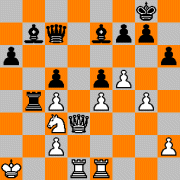 Karachurin - Bennedik, correspondence 2004
Karachurin - Bennedik, correspondence 2004
1.e4 c5 2.Nf3 d6 3.d4 cxd4 4.Nxd4 Nf6 5.Nc3 a6 6.Bg5 e6 7.f4 Qb6 8.Nb3 Nbd7 9.Qf3 Be7 10.O-O-O Qc7 11.Bd3 b5 12.a3 Rb8 13.Kb1 b4 14.axb4 Rxb4 15.Rhe1 Bb7 16.Qe2 h6 17.Bh4 O-O 18.Na2 Rb6 19.Bf2 Nc5 20.Bxc5 dxc5 21.Nd2 Rb8 22.Nc4 Rb5 23.f5 e5 24.g4 Nd7 25.Qf2 Nb6 26.b3 Rd8 27.Qg3 Rd4 28.Nc3 Nxc4 29.Bxc4 Rb6 30.Na4 Rbd6 31.Nc3 Rxc4 32.bxc4 Rb6+ 33.Ka1 Rb4 34.Qd3 (see diagram)
34...Bd5
Truly stunning. I can imagine having seen Re8 in the previous example, but not this one. The unguarded d5-square is attacked four times, or if you wish (the Rd1) even five times. After 34...Qa5+, Black would still be better, but only Bd5 wins. It threatens Bxc4, and every capture has its drawbacks, e.g. 35.N(Q)xd5 Qa5+ and quickly mate, or 35.exd5 e4 and the long diagonal decides: 36.Qg3 Qa5+ 37.Na2 Bf6+ 38.c3 Ra4 39.Qb8+ Kh7 40.Qb3 Bxc3+ and Bxe1. So: 35.cxd5 c4 36.d6 After 36.Qd2 (else Qa5+ and c3) Bg5 37.Qe2 Qa5+ 38.Na2 c3 decides after all. 36...Qa5+ 37.Na2 cxd3 38.dxe7 Rb8 39.Rb1 Re8 40.cxd3 Rxe7 41.Rb8+ Kh7 42.Rc1 Rc7 43.Kb1 Rxc1+ 44.Nxc1 Qd2 45.Rb2 Qd1 46.Ra2 Qg1 47.Rxa6 Qxh2 and White resigned.
(Notes based on those by Martin Bennedik.)
259. 1 October 2004:
The King on the wrong square mafia
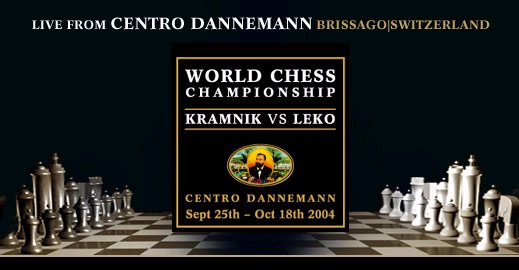
Thanks to James Willis for drawing my attention to the positions of the white King and Queen in the logo for the Kramnik - Leko match. "How can we expect Hollywood to get things right if our World Championship conveners can't?" he comments.
Perhaps conventions are different for 8x12 (14?) boards.
But it's not unique at that level.
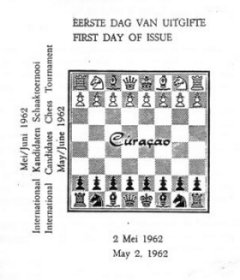 This is the image on the "First day of issue" envelope at the occasion of the Candidates Tournament in Curaçao, 1962. Not only is Black at the bottom, the board's orientation is wrong as well. Note that the diagram cannot have been mirrored unintentionally; Knights never face right in diagrams.
This is the image on the "First day of issue" envelope at the occasion of the Candidates Tournament in Curaçao, 1962. Not only is Black at the bottom, the board's orientation is wrong as well. Note that the diagram cannot have been mirrored unintentionally; Knights never face right in diagrams.
(Found in Mesman's De artistieke schaakstudie.)
But chesspublishers themselves do not always get things right.
Better chess might start with knowing where to put King and Queen in the initial position - thanks to Rob Eisler for showing me that cover. On the cover of the Charushin book, all the colors are reversed - the King on a5 is white and the one on a8 is black and so on. White is in the process of playing Mitrofanov's famous 7.Qg5; see A genius' bad luck, elsewhere on this site.
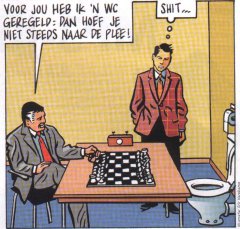 My collection of chessboards with a dark square in the right hand corner is too large to show, but I especially like this cartoon from the Dutch popular science magazine KIJK. The guy on the left says: "I took care of a toilet for you, so you don't have to go to the john all the time," - but I like the chess clock he brought even better.
My collection of chessboards with a dark square in the right hand corner is too large to show, but I especially like this cartoon from the Dutch popular science magazine KIJK. The guy on the left says: "I took care of a toilet for you, so you don't have to go to the john all the time," - but I like the chess clock he brought even better.
But sometimes chess expertise comes from unexpected sides. Michael Hogervorst sent me some screenshots of a chessgame played in Droomzicht, the recent new (Dutch) version of the Sims. Not only does the board have a light square on the right hand side, the characters play good chess, too.
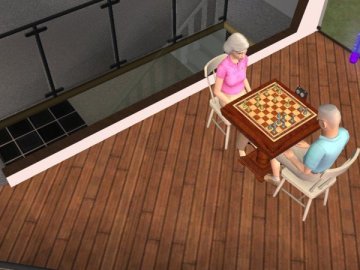 Cecile Oud - Hendrik Oud, Droomzicht, Sims 2
Cecile Oud - Hendrik Oud, Droomzicht, Sims 2
1.e4 c6 2.d4 d5 3.exd5 cxd5 4.c4 Nf6 5.Nc3 Nc6 6.Nf3 Bg4 7.cxd5 Nxd5 8.Qb3 Bxf3 9.gxf3 e6 10.Qxb7 Nxd4 11.Bb5+ Nxb5 12.Qc6+ Ke7 13.Qxb5 Nxc3 14.bxc3 This is the position in the screenshot. 14...Qd7 15.Rb1 Rd8 16.Be3 Qxb5 17.Rxb5 Rd7 18.Ke2 f6 19.Rd1 Rxd1 20.Kxd1 Kd7 21.Rb8 Kc6 22.Bxa7 g5 23.a4 Bg7 24.Rb6+ Kd5 25.Rb7 Bf8 26.Rb8 Bg7 27.Rb5+ Kc6 28.Rb6+ (see diagram below)
Here the game ended because the Sims were hungry. All Hogervorst's efforts to have them continue failed between moves 25 and 28 when Hendrik swept the pieces off the board.
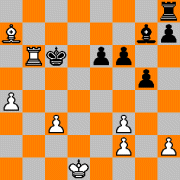 As Hogervorst rightly remarks, the Sims developers must have a real chess buff on their team, as the Ouds follow a game Fischer - Euwe, Olympiad Leipzig, 1960. That game ended with: 28...Kd5 29.a5 f5 30.Bb8 Rc8 31.a6 Rxc3 32.Rb5+ Kc4 33.Rb7 Bd4 34.Rc7+ Kd3 35.Rxc3+ Kxc3 36.Be5 and Black resigned.
As Hogervorst rightly remarks, the Sims developers must have a real chess buff on their team, as the Ouds follow a game Fischer - Euwe, Olympiad Leipzig, 1960. That game ended with: 28...Kd5 29.a5 f5 30.Bb8 Rc8 31.a6 Rxc3 32.Rb5+ Kc4 33.Rb7 Bd4 34.Rc7+ Kd3 35.Rxc3+ Kxc3 36.Be5 and Black resigned.
PS 3 October:
 Steve Wrinn sent me his favourite King-on-the-wrong square. It's the photo IBM released of dr. C.J. Tan, the non-playing captain of the Deep Blue team that beat Kasparov, proudly posing next to a chessboard - here on the cover of Inside Chess, 9 June 1997.
Steve Wrinn sent me his favourite King-on-the-wrong square. It's the photo IBM released of dr. C.J. Tan, the non-playing captain of the Deep Blue team that beat Kasparov, proudly posing next to a chessboard - here on the cover of Inside Chess, 9 June 1997.
258. 25 August 2004:
Burn's immortal move
In his mammoth Amos Burn, a Chess Biography (972 large, double-column pages, 2 kilograms, 75 dollars), Richard Forster gives one, up to now unknown, move by Burn which is worth the entire effort.
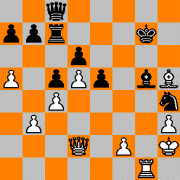 MacDonald - Burn, offhand game, Liverpool 1910
MacDonald - Burn, offhand game, Liverpool 1910
1.e4 e5 2.Nf3 d6 3.d4 Nd7 4.Nc3 Ngf6 5.Bc4 Be7 6.O-O O-O 7.Re1 c6 8.d5 c5 9.Bg5 h6 10.Be3 Kh7 11.h3 Nb6 12.Bd3 Bd7 13.a4 Rc8 14.a5 Na8 15.b3 Nc7 16.Ne2 Nce8 17.c4 Ng8 18.g4 g6 19.Ng3 Ng7 20.Qd2 Rc7 21.Kh2 Qc8 22.Rg1 f5 23.gxf5 gxf5 24.exf5 Nxf5 25.Nh5 Kh8 26.Rxg8+ Rxg8 27.Bxh6 Be8 28.Bg7+ Rxg7 29.Nxg7 Kxg7 30.Rg1+ Bg6 31.Ng5 Nh4 32.Bxg6 Bxg5 33.Bh5
(see diagram)
33...Qg4
34.Rxg4 Nf3+ 35.Kg2 Nxd2 36.Rxg5+ Kh6 37.h4 Nxb3 38.Rf5 Nxa5 39.Be2 Kg7 40.h5 Rf7 41.Rg5+ Kh8 42.h6 Rf6 43.Rh5 Rf4 44.Rg5 Nxc4 45.Bd3 Nb2 46.Bc2 c4 47.Rg7 Nd3 48.Bb1 Rxf2+ 49.Kg3 Rb2 and White resigned.
About his incredible 33...Qg4, Burn has said that it "seems to show that there is luck in chess," because 33.Be4 was winning. Forster calls Qg4 "the most spectacular move of his entire career", but it comes close to being the most spectacular move of any career.
In my series The 110 most fantastic moves ever played, it certainly belongs in the top ten - in fact it is more amazing and wonderful than Marshall's comparable Qg3 against Lewitzky, which I put in third place.
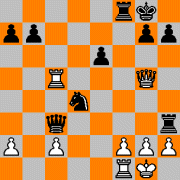 Black to play
Black to play
Levitzky - Marshall
Breslau 1912
Like Burn's Qg4, the famous 23...Qg3 is a silent Queen-move to a square where it can be captured in three ways, but that square is also defended once, and the whole move is somehow more obvious.
If we define Burn's move as a non-checking, non-capturing Queen-move to an undefended square where it can be captured in three ways, then Chess Query Language can search for it, and it doesn't even find one endgame study where such a thing happens. But it does find one other game with a move that meets the specifications.
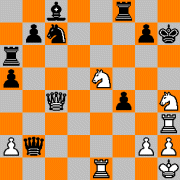 Sam Loyd - Moore, New Jersey 1876
Sam Loyd - Moore, New Jersey 1876
1.e4 e5 2.f4 exf4 3.d4 d5 4.Bd3 Nf6 5.Bxf4 c5 6.Bg5 dxe4 7.Bxe4 cxd4 8.Bxf6 Qxf6 9.Nf3 Bc5 10.O-O O-O 11.Nbd2 d3+ 12.Kh1 dxc2 13.Bxh7+ Kxh7 14.Qxc2+ Qg6 15.Qxc5 Na6 16.Qb5 Nc7 17.Qc4 Qb6 18.Nh4 a5 19.Ndf3 Ra6 20.Ne5 f6 21.Rf3 Qxb2 22.Re1 f5 23.Rh3 f4 (see diagram) and now 24.Qe6 (a Novotny, like Burn's Qg4) mates in three moves.
However, as Loyd himself mentioned, 24.Qe6 was not really played. Instead, he announced a mate in 6, beginning with 24.Nf5+. Only a quarter of a century later, did he "announce a mate more in accordance with the modern preference for problems in a few moves," with Qe6.
That means that Burn's move is unique. "It is surprising," writes Forster, "that apart from the Chess Amateur no magazine or book ever seems to have reprinted this electrifying combination."
PS 26 August:
I only looked for wins with a Burn-move but Harold van der Heijden, also searching for draws in his own famous study-database, found one study with a Burn-move.
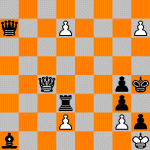 White to play and draw
White to play and draw
J. van Reek
EG, 1992
1.Qd4 is the only move that draws; 1.h8Q+ Bxh8 2.Qd4 Rxd4 loses. 1...Qxd4 2.d8Q+ And not 2.h8Q+ Qxh8 3.d8Q+ Rxd8) 2...Qxd8 3.h8Q+ with stalemate.
This inspired Van der Heijden to construct a position (a "sketch", he calls it) where this effect is maximized:
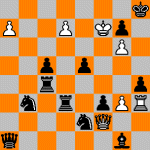 White to play and win (sketch)
White to play and win (sketch)
H. van der Heijden, 2004
1.Qd4, a silent Queen move to a square that is attacked eight times, is the only move that does not lose, and in fact mates in 3.
Eight possible captures of the Queen is of course the maximum without promoted pieces.
PS 6 October:
When Frits Fritschy showed the Burn position at his club, but erroneously placed the Rc7 on d8, one player, Wouter Oosthout, immediately found another brilliant solution: 1...Nf3+ 2.Bxf3 Qxh3+ 3.Kxh3 Rh8+, winning back the Queen. However, this is refuted by 4.Bh5. A few minutes later, Oosthout found Qg4 which here too, leads to a better game for Black.
257. 24 August 2004:
Surviving the Djordjevic Bishop sacrifice
On my
records page, the "Shortest game" is:
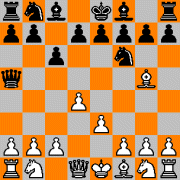 Djordjevic - Kovacevic, Bela Crkva 1984
Djordjevic - Kovacevic, Bela Crkva 1984
and
Vassallo - Gamundi, tt Spain, Salamanca 1998
1.d4 Nf6 2.Bg5 c6 3.e3 Qa5+ and White resigned.
Amazingly, these moves have been copied several other times in serious
games; see Chess Diary item 149 and this Dutch column.
Among them, there is even a game Mory - Hareux, Besançon 1999 in which White escaped with a draw.
Recently, as Justin Horton informs me, there was another White who survived the "Djordjevic Bishop sacrifice".
Skembris - Rodriguez, Dos Hermanas internet 8'+2", 2004
1.d4 Nf6 2.Bg5 c6 3.e3 Qa5+ 4.Nc3 Qxg5 5.Nf3 Qa5 6.Bd3 d5 7.0-0 Bg4 8.h3 Bh5
9.a3 e6 10.g4 Bg6 11.Ne5 Bd6 12.f4 Be4 13.g5 Bxd3 14.cxd3 Nfd7 15.Qh5 g6 16.Qg4 c5
17.Rac1 Nc6 18.Nxd7 Kxd7 19.Nxd5 cxd4 20.Nf6+ Ke7 21.e4 Rac8 22.e5 Nxe5 23.fxe5 Qxe5 24.Kg2 h5 25.Qh4 Qe2+ 26.Qf2 Qxf2+ 27.Kxf2 Bf4 28.Rxc8 Rxc8 29.Ne4 Rc2+ 30.Kf3 Be5
31.Rf2 Rxf2+ 32.Nxf2 f6 33.gxf6+ Bxf6 34.Ne4 Be5 35.Ng5 Bf6 36.Ne4 Be5 37.Ng5 Bf6
38.Ne4 Be5 and in this position where Black still has winning chances, a draw
was agreed - or perhaps claimed.
256. 17 August 2004:
The table near the middle door
On 27 November 1959, in the Villa Crespo chess club in Buenos Aires, the following rather dull chess game was played.
Martinez - Castelli, Buenos Aires 1959
1.d4 d5 2.Nf3 e6 3.e3 Nf6 4.Bd3 c5 5.c3 Nc6 6.Nbd2 Bd6 7.O-O O-O 8.Qe2
e5 9.dxc5 Bxc5 10.e4 d4 11.Nb3 Bb6 12.cxd4 Nxd4 13.Nbxd4 Bxd4 14.Nxd4
Qxd4 15.Be3 Qd6 16.Rac1 b6 17.Rfd1 Bb7 18.Bc4 Qe7 19.f3 Rfd8 20.Rc2 Rxd1+
21.Qxd1 Rd8 22.Rd2 Rxd2 23.Qxd2 Qd7 24.Qxd7 Nxd7 25.Bb5 Nb8 26.Kf2 Bc6
27.Bc4 Kf8 28.Ke2 Ke7 29.Kd2 f6 30.Kc3 Kd6 31.b3 Nd7 32.Bc1 a5 33.Ba3+
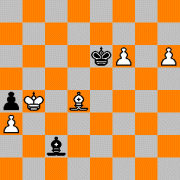 Kc7 34.Bg8 h6 35.Be7 Bb5 36.g3 Be2 37.f4 exf4 38.gxf4 g5 39.fxg5 fxg5 40.Kd4 Bg4 41.Kd5 Bd1 42.Be6 Bf3 43.Bf5 Bg2 44.Bd6+ Kd8 45.Ke6 b5 46.a3 a4
47.bxa4 bxa4 48.Kf7 Nb6 49.Kg6 Nc4 50.Bb4 Ne3 51.Kxh6 Nxf5+ 52.exf5 Ke8
53.Kxg5 Kf7 54.h4 Bd5 55.h5 Kg7 56.Bc3+ Kf7 57.h6 Kg8 58.Kg6 Bf7+ 59.Kf6
Bc4 60.Ke7 Bd5 61.f6 Bc4 62.Kd6 Bb3 63.Kc5 Kh7 64.Bd2 Kg8 65.Kb4 Bc2 66.Be3 Bb3
67.Bd4 Kh7 68.Be3 Kg8 69.Bf4 Bc2 70.Be5 Kf7 71.Bd4 Ke6 (see diagram)
Kc7 34.Bg8 h6 35.Be7 Bb5 36.g3 Be2 37.f4 exf4 38.gxf4 g5 39.fxg5 fxg5 40.Kd4 Bg4 41.Kd5 Bd1 42.Be6 Bf3 43.Bf5 Bg2 44.Bd6+ Kd8 45.Ke6 b5 46.a3 a4
47.bxa4 bxa4 48.Kf7 Nb6 49.Kg6 Nc4 50.Bb4 Ne3 51.Kxh6 Nxf5+ 52.exf5 Ke8
53.Kxg5 Kf7 54.h4 Bd5 55.h5 Kg7 56.Bc3+ Kf7 57.h6 Kg8 58.Kg6 Bf7+ 59.Kf6
Bc4 60.Ke7 Bd5 61.f6 Bc4 62.Kd6 Bb3 63.Kc5 Kh7 64.Bd2 Kg8 65.Kb4 Bc2 66.Be3 Bb3
67.Bd4 Kh7 68.Be3 Kg8 69.Bf4 Bc2 70.Be5 Kf7 71.Bd4 Ke6 (see diagram)
72.Kb5 Kd7
73.Bc3 Kd6 74.Bb4+ Ke6 75.Be7 Kd7 76.Kb4 Ke6 77.h7 Bxh7 78.Kxa4 Kd7 79.Kb5 Bg8
80.Kb6 Bb3 81.Bc5 Ke6 82.Bd4 Kd7 83.Bc3 Kd6 84.Bb4+ Ke6 85.Be7 and a draw was agreed.
A little over a month later, on 5 January 1960, the same Castelli played this
completely different game.
Castelli - Fedorovsky, Buenos Aires 1960
1.e4 Nc6 2.d4 e5 3.Nf3 exd4 4.Bc4 Nf6 5.O-O Bc5 6.e5 d5 7.exf6 dxc4 8.
fxg7 Rg8 9.Bg5 Qd6 10.Re1+ Be6 11.Nbd2 Qd5 12.Ne4 Be7 13.Nf6+ Bxf6 14.
Bxf6 Qf5 15.Bh4 Rxg7 16.Nxd4 Nxd4 17.Qxd4 Qg4 18.Qe4 Qxe4 19.Rxe4 Kd7 20.
Rd1+ Kc6 21.Re5 Rag8 22.g3 b5 23.a3 Rg6 24.f3 a6 25.Kf2 h6 26.Rd4 Bc8 27.
g4 Rd6 28.Ke3 Rgg6 29.Bg3 Rxd4 30.Kxd4 Rd6+ 31.Ke3 Re6 32.Rxe6+ Bxe6 33.
Bf4 h5 34.gxh5 c3 35.bxc3 Bf5 36.Kd4 f6 37.Bg3 Kd7 38.Kd5 Bxc2 39.Bh4 Bd1
 40.h6 c6+ 41.Kc5 Bc2 42.Bxf6 a5 43.c4 bxc4 44.Kxc4 a4 45.Kb4 Ke6 46.Bd4
Kf7 47.h7 c5+ 48.Bxc5 Kg7 49.Kc3 Bd1 50.f4 Kxh7 51.f5 Bg4 52.f6 Kg6 53.
Bd4 Be6 54.Kb4 Bb3 55.Kc5 Bd1 56.Kd6 Kf7 57.Ke5 Bc2 58.h4 Bd1 59.Kf5 Bc2+
60.Kg5 Bb3 61.Bc3 Bc4 62.Kf5 Be2 63.Kg5 Bc4 64.h5 Bb3 65.Kf5 Bd1 66.h6
Bc2+ 67.Ke5 Bb1 68.Kd6 Bc2 69.Bd4 Bh7 70.Kc5 Ke6 71.Kb4 Bc2 (see diagram)
40.h6 c6+ 41.Kc5 Bc2 42.Bxf6 a5 43.c4 bxc4 44.Kxc4 a4 45.Kb4 Ke6 46.Bd4
Kf7 47.h7 c5+ 48.Bxc5 Kg7 49.Kc3 Bd1 50.f4 Kxh7 51.f5 Bg4 52.f6 Kg6 53.
Bd4 Be6 54.Kb4 Bb3 55.Kc5 Bd1 56.Kd6 Kf7 57.Ke5 Bc2 58.h4 Bd1 59.Kf5 Bc2+
60.Kg5 Bb3 61.Bc3 Bc4 62.Kf5 Be2 63.Kg5 Bc4 64.h5 Bb3 65.Kf5 Bd1 66.h6
Bc2+ 67.Ke5 Bb1 68.Kd6 Bc2 69.Bd4 Bh7 70.Kc5 Ke6 71.Kb4 Bc2 (see diagram)
And from a very different opening, the same position has arisen - at the same move, again in Buenos Aires, at the Villa Crespo club, in the same room and at the same table; the one near the middle door to the balcony. The only slight difference was that Castelli was now White, and knew what his opponent should have done: 72.Kb5 Kd7
73.Bf2 Kd6 74.Bh4 Ke6 75.Kb4 Kf7 76.h7 Bxh7 77.Kxa4 Bg8 78.Kb5 Ke6 79.
Kb6 Kd7 80.a4 Bd5 81.a5 Kd6 82.a6 and Black resigned.
Thanks to Eduardo Bauzá Mercére for relating this remarkable coincidence.
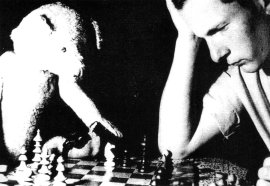 255. 10 August 2004:
The eternal recurrences of Alois Johandl (1931 - 2004)
255. 10 August 2004:
The eternal recurrences of Alois Johandl (1931 - 2004)
In the latest issue of Probleemblad, I read that the Austrian Alois Johandl, a great composer of my favourite kind of chess problem, has died on 9 July. He was 73. In the picture, he is 20, and composing in front of his teddy bear. I took it from Dreiklang (Verlag Friedrich Chlubna, Vienna 2001) - a book with his compositions and those of his friends and compatriots Klaus Wenda and Friedrich Chlubna.
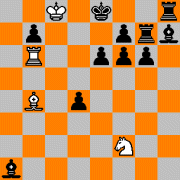 Mate in 5
Mate in 5
Alois Johandl
Schweizerische Arbeiter Schach-Zeitung, 1967
Black cannot castle, but White cannot mate him with 1.Rd6, because then he can castle.
1.Ne4! d3 2.Nd6+ Ke7+ 3.Ne8+ Kxe8 and the white Knight has vanished, but also Black's right to castle: 4.Rd6! Ke7+ 5.Rd8 mate. Two cross-checks by White.
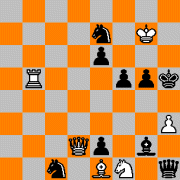 Mate in 6
Mate in 6
Alois Johandl
Probleemblad, 1998
Solvers found this very hard, writes Johandl. 1.Ng3+ Kh4 2.Nxf5+ Kh3! does not work; White needs a different tailpiece for his battery.
1.Bh4! Kxh4 2.Qe1+ Kh5 and now: 3.Ng3+ Kh4 4.Nxf5+ Kh5 5.Qh4+ gxh4 6.Ng3 mate. It's very unlikely in the starting position that the 5th rank will be the mating line.
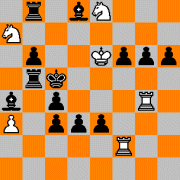 Mate in 7
Mate in 7
Alois Johandl
1st Prize, Freie Presse, 1998
Forming a battery with 1.Nd6 (threat: Rxc4 mate) Rb4 2.Ne4+ etc. seems promising, so why 1.Rd4! (threatening Rd5 mate)? Because after 1...Kxd4 2.Rf4+ Kc5 3.Nd6 Rb4 4.Ne4+ White has the same battery, and the vacated square f2, which he needs for 4...Kd4 5.Nf2+ Kc5 6.Nxd3+ cxd3 7.axb4 mate.
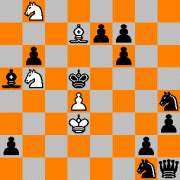 Mate in 10
Mate in 10
Alois Johandl
1st Prize, Schach-Archiv, 1989
This problem shows Johandl's favourite theme (a mechanism, in fact) - the recurrence of positions. White has a plan that doesn't work immediately - so he executes a manoeuver that forces Black to weaken his position, goes back to the initial position and executes the original plan after all.
White would like to play 1.Na6 and 2.Nac7 mate, but right now, this is refuted by 1...Qh2. Therefore: 1.Nc7+ Kd6 2.Ne8+ Kd5 3.Bb5 (threatening Bc4 mate) 3...Ke6 4.Ke4 f5+ 5.Kd3 f4 Now the diagonal h2-c7 is closed, so the clock is turned backwards: 6.Bd7+ Kd5 7.Nc7+ Not yet 7.Na6 b5! Kd6 8.Nb5+ Kd5 and now everything is back, except for the Pf6 which is at f4. So: 9.Na6 and 10.Nac7 mate.
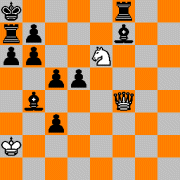 Mate in 5
Mate in 5
Alois Johandl
Commended, Deutsche Schachblätter, 1966
Finally, a witty variation of the smothered mate.
It is not yet possible, because after 1.Nc7+ Kb8 2.Nxa6+ Ka8 3.Qb8+ Rxb8, the Na6 would be pinned. With the surprising 1.Ka1, White threatens 2.Nc7+ Kb8 3.Nxd5+ Ka8 4.Nxb6 mate, which was not possible immediately because of the pin by Bf7. Black guards b6 with 1...Ba5, but this in turn is an anticipatory unpin: 2.Nc7+ Kb8 3.Nxa6+ Ka8 4.Qb8+ Rxb8 and now 5.Nc7 mate is possible after all.
254. 6 August 2004:
To win the right of castling
In the Belén theme (see item 253) the idea was to make castling as unlikely as possible - in the study below, it's all the solver can think about.
This study came third in the endgame section of the recent World Chess Composition Tournament (won by Russia). The set theme was that at one point, White must have a favourable manoeuver which is prevented by one of his own men. He actively or passively rids himself of that man, returns to the relevant position, and now executes the manoeuver.
Costeff thought of a unique motivation for this sacrifice.
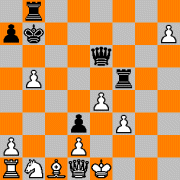 White to play and win
White to play and win
Gady Costeff (Israel)
3rd Place, World Chess Composition Tournament, 2003
One of the craziest starting positions I've ever seen. Black has some
very strong threats (Rg5, Rh5, Qd6, Qb6) so White must be quick.
1.Qa4 Rxf3
After 1...Rh5 2.Qa6+ Qxa6 3.bxa6+ Kxa6 4.Kf2 Rxh7 5.Nc3 White has a technical win.
2.Qa6+ Qxa6 3.bxa6+
If Black now plays 3...Kxa6, then 4.Ba3 (to prevent Rbf8) Rh8 5.Nc3 and White escapes in time and wins technically. But Black plays for stalemate:
3...Ka8
And the relevant position has arisen for the first time. White would like to play 4.Bb2 Rbf8 5.O-O-O but the Nb1 is in the way. Therefore:
4.Ba3 Rxb1+
Again, 4...Rh8 5.Nc3 Rxh7 6.O-O-O is a technical win
5.Bc1
And not 5.Rxb1 Rf1+ 6.Kxf1 stalemate. Now, 5...Rf8 is met by 6.h8Q and after Rxc1+ 7.Rxc1 Rxh8 8.Kf2 White has an easily won endgame, while after 6...Rxh8 7.Rxb1 Black does not have a Rambling Rook (7...Rh2 8.Ra1!)
5...Rb8
And the position after 3...Ka8 is back - minus the Nb1. Which means White has won the right to castle:
6.Bb2 Rbf8 7.O-O-O and wins.
253. 24 July 2004:
The Belén Theme (+ PS 4 August)
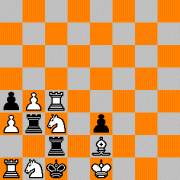 Mate in 4
Mate in 4
Original, 17 July 2004
Manuel Pérez Carballo
"The Belén Theme"
This problem introduces a theme which, to the composer's and my knowledge
and surprise, seems not to have been thought of before. Pérez Carballo (a
Spanish chess player of around 2150 living in Glasgow - one of the first
things he did there was to go to a library where he could see with his own eyes
Barbier's 1895
Glasgow Weekly Citizen articles in which the Saavedra position was
discovered - "I was almost crying of excitement as I turned the pages of the
thick bound volumes until I got to the very colums") always felt attracted
to the unusual in chess. He didn't play the Spanish but the Portuguese (1.e4 e5
2.Bb5) and composed some problems and studies with castling and en passant
ideas, but this is his first publication.
The idea for this problem had "haunted him for almost a
decade", but the best he had been able to come up with was a version with an
inexcusably bad key; the capture of a Queen. Then one weekend, he decided to
give it one last, all-out try. When he went to bed early Sunday morning,
nothing had worked but after waking up, he realised he had seen the solution
in a dream. It still needed a finishing touch - the a4 and b4 pawns had been
absent - but when he added them, it worked.
1.Nxa4 threatening 2.Nbc3+ and mate. Black has two defences:
a) 1...Rxb1 when 2.Bd3 Rxa1 3.Rxc2+ Kb1 4.Nc3 is mate, and
b) 1...Rxc4 2.Nbc3+ Kc2 (2...Rb1 3.Bd3 Rxa1 4.Ne2 mate)
3.Bd3+ Kxd3 4.O-O-O mate
The switchback mate 4.Nc3 in variation a) and the model mate 4.Ne2
in b) are nice, but 4.O-O-O mate in b) is the central idea of the Belén
Theme: in a direct-mate, the Black King starts at c1 and is mated by O-O-O.
But why Belén theme? Pérez Carballo sent me his problem on 17 July,
because on that day it was 5 years ago he met
 his "other passion outside chess", his partner Belén - the Spanish form of
Bethlehem. He dedicates his problem to her, and names the theme after her,
wondering if ever before a chess theme has been named after a loved one.
his "other passion outside chess", his partner Belén - the Spanish form of
Bethlehem. He dedicates his problem to her, and names the theme after her,
wondering if ever before a chess theme has been named after a loved one.
So far so good, but there could be two reasons he's holding his breath now.
A reader (Hanspeter Suwe for instance, the editor of the castling magazine
König & Turm) might know of an earlier Belén problem - and a composer
might be inspired to make a better Belén, either improving on this setting,
or creating an new one. Pérez Carballo does realize his problem is not the
perfect rendering of the theme. For one thing, the ideal Belén would be a
three-mover. The flight-taking key is not very good; a black piece on
b1 would conceal the solution better (but then it would have to be
a four-mover) and he did not manage the Meredith form - 12 pieces or
less. But the Pa3 is needed to stop 1.Na3+; the Pa4 is needed to stop 1.Nd2+
Kb2 2.Rb1+ Kxa3 3.Rxb3 mate, and the Pb4 is needed to stop 1.Nd2+ Kb2 2.Rb1+
Kxa3 3.Rxa4 mate.
But he did create the first Belén - nobody can take that from him.
PS 26 July: Within hours, the English problemist Michael McDowell
sent me a Belén problem that was both a Meredith and a three-mover.
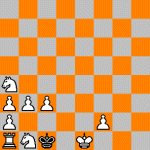 Mate in 3
Mate in 3
Michael McDowell
Original, 2004
1.c4 Kc2 2.Nbc3 Kd3 3.O-O-O mate
"Or start Na4 on c3 for a 9-piece setting if you don't mind a flight-taking key,"
he added. Man for man, that setting was later independently also sent to me
by Joshua Green. (The key is then 1.Na4)
Just a few minutes later, McDowell sent me this miniature setting, for the price
of a checking key.
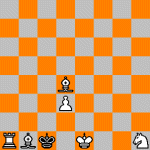 Mate in 3
Mate in 3
Michael McDowell
Original, 2004
1.Ba2+ Kc2 2.Ng3 Kxd3 3.O-O-O mate.
And next morning, he sent me "something that looks like a proper chess problem."
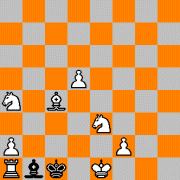 Mate in 4
Mate in 4
Michael McDowell
Original, 2004
1.Nd1! Not only a black piece on b1, but also a
key which fills up all the castling squares.
1...Kc2 2.Ndc3 Bxa2 (Kc1 3.Nxb1 Kc2 4.Na3 mate)
3.Bxa2 Kd3 4.O-O-O mate.
PS 27 July: I may, through lack of attention, have created
a awkward problem for the composers. They do care a lot, and rightly so, about
precedence, anticipation, novelty of idea & setting.
Between sending me his first Belén problem on 17 July
and my publication of it on 24 July, Pérez Carballo also sent me a gamefile
with games of his, and at the end two "Belén Theme" four-movers, the second
being a new version which I must admit did not really take root in my mind.
Right after my publication of the Belén problem,
Michael McDowell sent me the two three-movers above and the next day, the
four-move version with 1.Nd1!
As it turns out now however, that other four-mover
in Pérez Carballo's gamefile anticipates, to a degree, McDowell's 1.Nd1
four-mover.
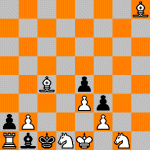 Mate in 4
Mate in 4
Manuel Pérez Carballo
Original, 2004
1.Nc3 Kc2 (Kxb2 2.Nxb1+ and 3.Na3 mate) 2.Nxa2 Bxa2
3.Bxa2 Kd3 4.O-O-O mate.
Largely the same setting and the same play. There can be no doubt that
McDowell's problem is better (at the
Chess Problem Discussion Board Pérez Carballo recognizes that) but there
is also no doubt Pérez Carballo had some of the ideas first - of course
without McDowell knowing that. Still, an anticipation. But: is an anticipation
an anticipation without publication?
Have I wronged somebody and if so, whom?
I'm afraid all I can do is turn beet-red, and
thank both composers for their work. The Belén Theme Story amounts to an
interesting insight into the development of a problem idea.
PS 28 July: The search is over - as was to be expected, Hanspeter Suwe
found a real anticipation in his archives.
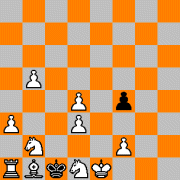 Mate in 4
Mate in 4
Markus Wettstein
Neue Zürcher Zeitung, 1968
1.Na4 f3 2.Ba2+ Kc2 3.Ndc3 Kxd3 4.O-O-O mate
Suwe adds he does not know the exact date of publication (judging from the photo
above, it's a pity that it couldn't be Belén's birthday) and nothing about the author.
"It is the same matrix which has also been found by Pérez Carballo and McDowell. The
problem by the last one is the best: very good construction with a fantastic key move:
1.Nd1!, a so called AZE (means Anti-Ziel-Element), a term for such a strategic
move, created by the Austrian composer Helmut Zajic."
Suwe thinks there might be even older examples and will
continue to look for them.
With this information, McDowell found Wettstein's (a Swiss) problem in a book
Kunstschach in der Schweiz / Les Echecs artistiques en Suisse" by Hans
Henneberger (1980), who comments: "A chess riddle in which one really wouldn't
expect castling!"
Finally, a 3-move miniature Belén without checking key, was
published on the
Kibitzer's Café
by "vonKrolock's Chess Friend Z. Kornin": White: Ke1, Ra1, Be6, Nb1, Nc5, Pf2;
Black: Kc1; 1.Na4 Kc2 2.Nbc3 Kd3 3.O-O-O mate. However, the flight-taking key is
bad and worse, it has some serious duals
on the second move; 2.Ke2 or 2.Bc4 also lead to (3.Na3) mate which make it in fact
incorrect. Joshua Green, who drew my attention to this, notes a wPa3 undoes these
duals, but then it's not a miniature anymore. McDowell's, with its checking
give-and-take key, is still the best miniature Belén-threemover. (NB: see pages 566 and 587 of that forum for the on-line development of a Valladao-Belén.)
PS 4 August: Thomas Beuman managed a Belén 3-move miniature without a checking
key, and without any duals. The key does take a flight square.
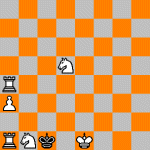 Mate in 3
Mate in 3
Thomas Beuman
Original, 2004
1.Rb4 Kc2 2.Nbc3 Kd3 3.O-O-O mate.
PS 8 August: Hauke Reddmann informs me that in 1977, when he was 16, he
had also composed a Belén.
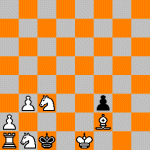 Mate in 3
Mate in 3
Hauke Reddmann
Inselschach, 1977
1.Na4 Kc2 2.Nbc3 Kd3 3.O-O-O mate.
PS 14 January 2005: And here is a (helpmate-)example from as far back as 1936.
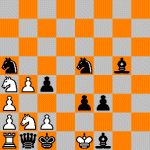 Helpmate in 3
Helpmate in 3
G. Paros
2nd Prize, Magyar Sakkvílag 1936
1.Kxc2+ Nd1 2.Qxb4+ Ndc3 3.Kd3 O-O-O mate.
Thanks to Zalmen Kornin and Frank Richter (and the
Chess Problems Forum) for pointing this out.
252. 10 July 2004:
Three Queens
 We're telling our own fortunes all the time - if only we knew how.
We're telling our own fortunes all the time - if only we knew how.
Jan Voormans is a strong Dutch chess player. He won
several city and regional championships, came second in the 1981 Dutch
Open, and is a correspondence IM. At 60 today, his FIDE rating is still
2243. But he is also an expert at draughts - and an immortal in that
game.
In his short draughts career (1966-1974) he made it
to the Dutch top league, where he beat several luminaries, and drew games
against three World Champions; Roozenburg, Sijbrands and Wiersma. He also
composed a few draughts problems, one of which, his Canalejas problem,
outshines the others by far. It is included in Ten Best Draughts'
Problems of All Time lists, and is acknowledged to be the best Canalejas
ever composed, among countless problems with that theme.
In a recent web-story Mijn
Probleem (in Dutch) he gives an account of the very special
circumstances that led to that problem.
In August 1979, at 35, he had great personal problems. His wife had separated
from him, and he was not allowed to see their daughter, then 2. He had already
ended his draughts' career but one night, he had the idea that a Canalejas,
ending with the multicapture 35 x 2, combining his and his
daughter's ages, might bring her back to him. He knew there were thousands of
Canalejas problems ending with that 35 x 2 capture, and perhaps to set a hurdle
that would lend his wish more power if he overcame it, he decided that his
35 x 2 multi-capture would be the capture of three Queens. That had never been
done, and might prove to be impossible.
Three months long, he worked feverishly on his problem.
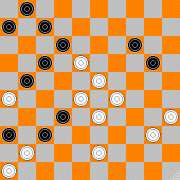
|
White to play and win
Jan Voormans, 1979
|
He was under time-pressure, because for the magic to work, the problem
had to be ready while his daughter was still 2, and her third birthday was
looming in February.
Then one day in November, his problem was ready.
It worked, it lived, it even fulfilled the "Sharp Rules" of draughts' composing.
Unbelieving that he had really done it, he looked at it every day for
hours, playing over the moves again and again: ("International" draughts'
rules; notation from top to bottom and left to right; see the
applet): 1.28-22 17x48
2.26x8 36x47 3.18-13 47x24 4.46-41 37x46 5.8-2 24x8 6.2x15 46x19 7.15-20
14x25 8.40-34 48x30 and now the magical 9.35x2, capturing
three Queens and winning - a position that had already been analysed in
1650 (on a chessboard), in one of the earliest draughts' books, by the
Spaniard Juan Garcia Canalejas.
For years however, Voormans kept his problem to himself, afraid it might
be stolen and published by somebody else under his name. Eventually,
he realised that he might die without anyone ever having seen his creation
and in 1983 he allowed a local paper to publish it in their draughts' column.
From there, it became something of a myth. But when in 1987 the 3-Queen-Canalejas
finally made it to the national draughts' magazines, Voormans was a forgotten
draughts' player, an almost Saavedra-like enigma, whose brilliant problem was
his only known draughts' deed.
All is well that ends well - Voormans' Canalejas-problem is now a classic,
under his own name. And, more important: he has good relations with his
daughter, and with her children. Triplets, three girls.
251. 10 July 2004:
Traffic lights
"If one would cancel all traffic rules and switch off all traffic lights,
watching city traffic on TV would be also awfully interesting!"
Oleg Romanishin on FIDE's efforts to make chess a TV spectator sport,
quoted by Rustam Kasimdzhanov in today's
Chess Today.
250. 6 July 2004:
You are requested to make a blunder
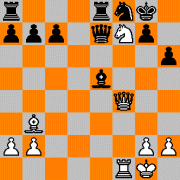 The Bond-movie From Russia with Love (1963) opens with the famous
chess scene. In Venice, the Czech Kronsteen plays in the "International
Grandmasters Championship Final" against the Canadian MacAdams. The score
is 11½ - 11½, suggesting a last game in a World Championship match. In
the position of the diagram, Kronsteen, a lighted cigarette in his hand,
plays Nxe5+, looking MacAdams straight in the eyes. He says: "Check," puts
the cigarette between his lips and pushes his clock button. The move is
also executed on a giant demonstration board in the playing hall, by a
valet who calls out: "Knight takes Bishop." A waiter steps onto the stage,
bringing both players a glass of water. Kronsteen takes a sip; a gesture
by the waiter makes him realize this is a message. Through the bottom of
the glass he reads on the napkin underneath: YOU ARE REQUESTED AT ONCE.
He pats his lips with the napkin, then tears it. MacAdams, looking
worried, plays Kh7 - this move too, is announced and played on the
demonstration board. Kronsteen gives him a stare again and with a
triumphant smirk plays Qe4+, this time without saying "check". The valet
at the demonstration board calls out: "Queen to King 4." MacAdams startles,
spectators rise. MacAdams topples over his King and says: "Congratulations
sir, that was a brilliant coup." Amidst applause, Kronsteen leaves the
board and the hall, ignoring congratulatory hands strectched out to him.
He walks to a ship in the harbour, where it turns out he works for the
terrorist organisation SPECTRE.
The Bond-movie From Russia with Love (1963) opens with the famous
chess scene. In Venice, the Czech Kronsteen plays in the "International
Grandmasters Championship Final" against the Canadian MacAdams. The score
is 11½ - 11½, suggesting a last game in a World Championship match. In
the position of the diagram, Kronsteen, a lighted cigarette in his hand,
plays Nxe5+, looking MacAdams straight in the eyes. He says: "Check," puts
the cigarette between his lips and pushes his clock button. The move is
also executed on a giant demonstration board in the playing hall, by a
valet who calls out: "Knight takes Bishop." A waiter steps onto the stage,
bringing both players a glass of water. Kronsteen takes a sip; a gesture
by the waiter makes him realize this is a message. Through the bottom of
the glass he reads on the napkin underneath: YOU ARE REQUESTED AT ONCE.
He pats his lips with the napkin, then tears it. MacAdams, looking
worried, plays Kh7 - this move too, is announced and played on the
demonstration board. Kronsteen gives him a stare again and with a
triumphant smirk plays Qe4+, this time without saying "check". The valet
at the demonstration board calls out: "Queen to King 4." MacAdams startles,
spectators rise. MacAdams topples over his King and says: "Congratulations
sir, that was a brilliant coup." Amidst applause, Kronsteen leaves the
board and the hall, ignoring congratulatory hands strectched out to him.
He walks to a ship in the harbour, where it turns out he works for the
terrorist organisation SPECTRE.
There is a funny twist hidden in this scene, as was pointed out to me by
Joop Leur. When Kronsteen receives his message that he is requested at once,
MacAdams makes a losing blunder at once. That nobody seems to have noticed
this before, could be because the position Kronsteen - MacAdams was taken
from the famous, then recent game Spassky - Bronstein, Leningrad 1960. But
in that game, 22...Kh7 was not a blunder; the other possibility
22...Ne6 is met by 23.Ng6 or Qe4 and the Ne6 soon falls. In Kronsteen - MacAdams
however, for some reason, the White pawns d4 and c5 were missing, allowing
Black a vital check on c5, which enables him to put up a tenacious and
possibly successful defence with 22...Ne6.
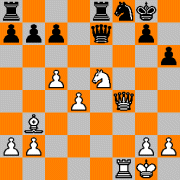
Spassky - Bronstein |
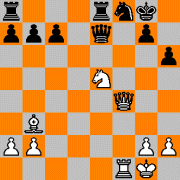
Kronsteen - MacAdams |
I've always wondered why those pawns were left out. In
the movie's credits, there is no mention of a chess consultant. There must
have been one, as the choice of the position, the score of 11½ - 11½ and
the names (Kronsteen/Bronstein) shows. Did this expert play a trick on the
filmmakers by making MacAdams an accessory with his blunder?
Who was that expert?
Spassky - Bronstein, Leningrad 1960
1.e4 e5 2.f4 exf4 3.Nf3 d5 4.exd5 Bd6 5.Nc3 Ne7 6.d4 O-O 7.Bd3 Nd7 8.O-O h6
9.Ne4 Nxd5 10.c4 Ne3 11.Bxe3 fxe3 12.c5 Be7 13.Bc2 Re8 14.Qd3 e2 15.Nd6 Nf8
16.Nxf7 exf1Q+ 17.Rxf1 Bf5 18.Qxf5 Qd7 19.Qf4 Bf6 20.N3e5 Qe7 21.Bb3 Bxe5
22.Nxe5+ Kh7 23.Qe4+ and Black resigned.
PS 3 September: On 2 september, the Chessbase site had an interesting article in which it was pointed out that Kronsteen - MacAdams was taken from Spassky - Bronstein, that Bronstein sounds like Kronsteen, that this was a game at 11½-11½ in the "International Grandmaster Championship", that Kronsteen says 'check' aloud, that two of Spassky's pawns didn't make it onto Kronsteen's board, and that without these pawns, Kh7 was a blunder because Ne6 would have drawn.
249. 2 July 2004:
Watchtowers
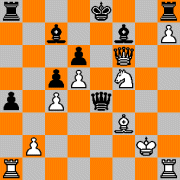 Szabo - Ristoja, Helsinki 1975
Szabo - Ristoja, Helsinki 1975
1.d4 Nf6 2.c4 c5 3.d5 e5 4.Nc3 d6 5.e4 Be7 6.Bd3 Nbd7 7.Nge2 Nf8 8.Ng3 g6
9.h4 h5 10.Nf1 Ng4 11.f3 Nh6 12.g3 a6 13.Qc2 Bd7 14.a3 Qb8 15.a4 Bd8 16.a5
Bc7 17.Bg5 Ng8 18.Nd1 f6 19.Bd2 Kf7 20.Nfe3 Nh6 21.Nf2 b6 22.axb6 Bxb6
23.f4 a5 24.Be2 Kg7 25.f5 Be8 26.g4 hxg4 27.Nfxg4 Nxg4 28.Bxg4 a4 29.fxg6
Nxg6 30.Nf5+ Kg8 31.h5 Nf4 32.Bxf4 exf4 33.h6 Ba5+ 34.Kf1 Kf8 35.Qf2
Qb3 36.Qxf4 Bc7 37.h7 Bf7 38.Qh6+ Ke8 39.Qxf6 Qd3+ 40.Kg2 Qxe4+ 41.Bf3
(see diagram) and Black resigned.
Notice anything strange about this game? (Thanks to David Paulowich for
showing it to me.) In the final position after move 41, all 4 Rooks are
still on their original squares, without having made one move between them.
It's one of the many new records on my updated
records page.
248. 28 June 2004:
En prise record
Rob Eisler pointed out to me that the en prise record for Rooks on my
records page,
which was 7 non-captures, was broken in
round 3 of the Open Libyan Championship - it's now 9 non-captures.
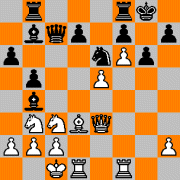 Almasi - Ye, Open Libyan Championship, 2004
Almasi - Ye, Open Libyan Championship, 2004
1.e4 c5 2.Nf3 Nc6 3.d4 cxd4 4.Nxd4 Qc7 5.Nc3 e6 6.Be3 a6 7.Qd2 Nf6 8.O-O-O Bb4
9.f3 Ne5 10.Nb3 b5 11.Qe1 Rb8 12.Qg3 Be7 13.f4 Nc4 14.e5 Nh5 15.Qf2 Nxe3
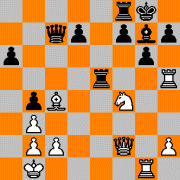 16.Qxe3 g6 17.g4 Ng7 18.Bd3 Bb7 19.Rhf1 O-O 20.f5 exf5 21.gxf5 Bb4 22.f6 Ne6
(see diagram)
23.Rf5 Rfe8 24.Rh5 Bf8 25.Rg1 Ng7 26.fxg7 Bxg7 27.Qf2 b4
28.Ne2 Bd5 29.Nf4 Bxb3 30.axb3 Rxe5 31.Bc4 Rf8 32.Kb1
(see diagram) 32...Rxh5 33.Nxh5 Bxb2 34.Kxb2 Qe5+ 35.Kb1 Qxh5
36.Qd2 a5 37.Rf1 Qh3 38.Qd6 and Black resigned
16.Qxe3 g6 17.g4 Ng7 18.Bd3 Bb7 19.Rhf1 O-O 20.f5 exf5 21.gxf5 Bb4 22.f6 Ne6
(see diagram)
23.Rf5 Rfe8 24.Rh5 Bf8 25.Rg1 Ng7 26.fxg7 Bxg7 27.Qf2 b4
28.Ne2 Bd5 29.Nf4 Bxb3 30.axb3 Rxe5 31.Bc4 Rf8 32.Kb1
(see diagram) 32...Rxh5 33.Nxh5 Bxb2 34.Kxb2 Qe5+ 35.Kb1 Qxh5
36.Qd2 a5 37.Rf1 Qh3 38.Qd6 and Black resigned
It should be noted that here, the rook moves to the attacked square,
and that it later moves from one attack by the pawn to another. In this game,
one capture would have been illegal, while in the older record there were three.
Then, Charles Milton Ling rightly remarks that the "Open Libyan Championship"
isn't really all that open.
PS 1 July: I did not include this record in the major update of my
records page
 of today. It just got too complicated. Is a piece attacked by a pawn when
that pawn is pinned? When the pawn's side is in check? When the pawn's side
gives a Zwischenschach? There were too many non-captures in that
category that I wasn't sure should be counted. Take
Kulashko - Smith, Fencible 1997. White played 65.Rc7 and after
65...Qxd5 he of course did not recapture, but played: 66.Rg7+ Kh8
67.Rxg5+ Kh8 68.Rg7+ Kh8 69.Rxg4+ Kh7 70.Rg7+ Kh8 71.Rf7+ Kf8 72.Rxf8+ Kxf8
73.exd5 and after some more moves, Black resigned.
of today. It just got too complicated. Is a piece attacked by a pawn when
that pawn is pinned? When the pawn's side is in check? When the pawn's side
gives a Zwischenschach? There were too many non-captures in that
category that I wasn't sure should be counted. Take
Kulashko - Smith, Fencible 1997. White played 65.Rc7 and after
65...Qxd5 he of course did not recapture, but played: 66.Rg7+ Kh8
67.Rxg5+ Kh8 68.Rg7+ Kh8 69.Rxg4+ Kh7 70.Rg7+ Kh8 71.Rf7+ Kf8 72.Rxf8+ Kxf8
73.exd5 and after some more moves, Black resigned.
Can the black Queen be said to have been en prise
for 7 moves (which would be the record for Queens) when all the non-captures
where Zwischenschachs? Records should be easily countable, and not
too technical.
247. 25 June 2004:
Q and Makruk with Kramnik
The
Spiegel-online interview with Kramnik was terrifyingly empty. Not Kramnik's
fault, when you see some of the questions:
Q: Does chess improve your ability to cope with life?
Q: Have you (...) ever missed a chance with a woman because you thought
too much or for too long?
Q: Is your approach with your family and friends dominated by strategy and tactics?
Q: Good chess players are often weird creatures and loners. How difficult is it
for you to form friendships that you find interesting?
Q: You are considered someone who has the deep Russian soul.
Q: Are you a genius?
Q: Do you use any psychological tricks to put yourself in a good mood?
Q: Assuming you had enough information about Iraq, would you be able to give
Bush some tactical advice?
Kramnik's best A was to the question about the deep Russian soul: "I don’t know
what that is supposed to mean."
Kramnik also stood his ground in Germany, in a game of Makruk (Thai chess)
he played earlier this year against
the German journalist and enthusiast of this game, René Gralla.
Sensation in the World of Makruk Thai
World Chess Champion Kramnik playing Makruk Thai for the first time
or:
The Kon-Tiki-Effect on the Chess-Board
are the headings under which Gralla sent me his story of that encounter.
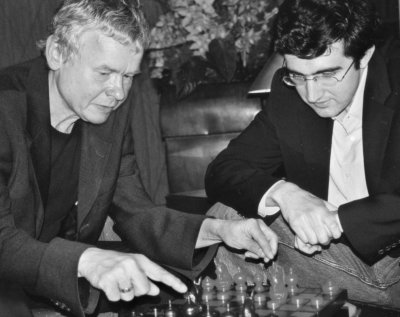 "The rhythm of Makruk Thai is somewhat restrained," writes Gralla, "so it is
very close to that great
historic version of chess, the Arabic Shatranj, that has blossomed during
the first Golden Age Of Chess at the Bagdad of the Caliphs, starting out at
the beginning of the 9th century. With the most inspiring consequence that,
by playing Makruk Thai, you get a real feeling for what it has been like
when such legendary personalities of the history of chess, the great
teachers and authors as-Suli and al-Lajlaj, have been waging their epic
battles while all the beautiful ladies of the harems - ladies who have been
great players too in many cases - were seducingly looking on ... promising
the rewards of paradise for the winner... That's why Makruk Thai is
chess history that is still alive and going on
strong: by playing a match of that variant from Southeast Asia you are
experiencing a kind of Kon-Tiki-effect on the chess-board."
"The rhythm of Makruk Thai is somewhat restrained," writes Gralla, "so it is
very close to that great
historic version of chess, the Arabic Shatranj, that has blossomed during
the first Golden Age Of Chess at the Bagdad of the Caliphs, starting out at
the beginning of the 9th century. With the most inspiring consequence that,
by playing Makruk Thai, you get a real feeling for what it has been like
when such legendary personalities of the history of chess, the great
teachers and authors as-Suli and al-Lajlaj, have been waging their epic
battles while all the beautiful ladies of the harems - ladies who have been
great players too in many cases - were seducingly looking on ... promising
the rewards of paradise for the winner... That's why Makruk Thai is
chess history that is still alive and going on
strong: by playing a match of that variant from Southeast Asia you are
experiencing a kind of Kon-Tiki-effect on the chess-board."
That almost reads like a car commercial, but it is a pity that for
all the historic Kon-Tiki-ness of Kramnik's first Makruk game, Gralla
forgot to write down the moves.
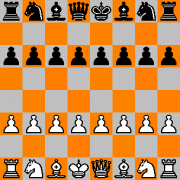 Kramnik - Gralla (Makruk), Bonn, May 2004
Kramnik - Gralla (Makruk), Bonn, May 2004
Gralla only remembers that in the initial
position (see diagram right) they played 1.c4 f5 2.Nc3 Nf6 3.Nge2 Nbd7 and
that in the end a "position like this" (diagram below) had
arisen. To follow the play there, we have to know that Kings, Rooks,
Knights and Pawns move as in our game, but the Queen is restricted to
diagonal one-square steps like the old Arabic firzan, just as the Bishop
which however, can also go one square straight forward. Pawns promote
on the sixth rank, and to Queen only. For more rules, see
Chess in Cambodia
elsewhere on this site, or the
Chess Variant Pages.
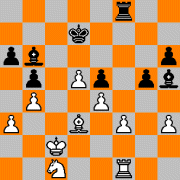 According to Gralla, Black could have equalised with 1...Bh4
2.Be2 Rf6 3.Rh1 Kd6, threatening 3...Bg3. But after 1...g4 2.hxg4 Bxg4 3.Rh1
Rxf3 4.Rxh6 Rf2+ 5.Kc3 Black was lost; Ba7 is met by 6.Rh7+
and Kc7 by 6.d6Q+ Therefore, he resigned.
According to Gralla, Black could have equalised with 1...Bh4
2.Be2 Rf6 3.Rh1 Kd6, threatening 3...Bg3. But after 1...g4 2.hxg4 Bxg4 3.Rh1
Rxf3 4.Rxh6 Rf2+ 5.Kc3 Black was lost; Ba7 is met by 6.Rh7+
and Kc7 by 6.d6Q+ Therefore, he resigned.
"Makruk Thai is more strategic than International Chess," Kramnik has said
after the game, expressing his wish to play a mixed match of Makruk Thai and
International Chess against Tor Pagnaam, the current Makruk champion of Thailand.
But will the reunification match Kramnik - Pagnaam ever take place?
246. 19 June 2004:
Open Libyan Championship
Today in Tripoli, the Open Libyan Chess Championship has started - an interesting
event with a strong field of 128 participants, many prominent grandmasters among them.
Here is a nice surprise from today's round 1.
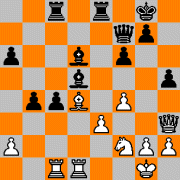 Vaganian - Ghaem Maghami
Vaganian - Ghaem Maghami
1.d4 Nf6 2.Nf3 e6 3.e3 b6 4.Bd3 Be7 5.O-O Bb7 6.c4 O-O 7.Nc3 d5 8.cxd5
exd5 9.b3 Nbd7 10.Bb2 a6 11.Rc1 Bd6 12.Bf5 Re8 13.Bxd7 Qxd7 14.Ne5 Qe6
15.Ne2 Rac8 16.Nf4 Qe7 17.Nh5 Nxh5 18.Qxh5 c5 19.f4 f6 20.Ng4 Qf7 21.Qh3
c4 22.Rfd1 b5 23.bxc4 dxc4 24.d5 h5 25.Nf2 b4 26.Bd4 Bxd5
(see diagram) 27.Bxf6 gxf6 28.Qg3+ Qg7 29.Rxd5 Qxg3
30.hxg3 Bc5 31.e4 a5 32.Kf1 a4 33.Nd3 cxd3
34.Rcxc5 Rxc5 35.Rxc5 Rxe4 36.Rd5 Re2 and White resigned.
245. 7 May 2004:
Véra and Vladimir
In Véra, Stacy Schiff's biography of Véra Nabokov, subtitled
Portrait of a marriage (to Vladimir Nabokov), there is of course
some chess. One quote, about their early days in the 40ties in Ithaca:
More than a few heads turned when, in the supermarket parking lot,
Véra set her bagged groceries down in the snow while she shuffeld for her keys,
then loaded the trunk. In the car her husband sat immobile, oblivious. A similar
routine was observed during a move, when Nabokov made his way into the new home
carrying a chess set and a small lamp. Véra followed with two bulky suitcases.
I take this opportunity to ask again a question that I asked a few years ago,
in item 5.
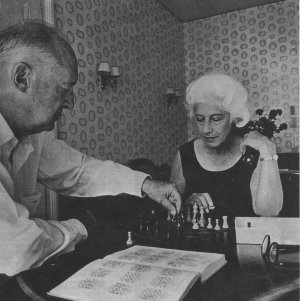
This is a picture of Vladimir and Véra, in 1968 in Montreux.
Which book could it be on the
table? Some books it looks like but is not:
- A volume in Wildhagen's series Weltgeschichte des Schachs
- Lommer & Sutherland's 1234 Modern End-Game Studies
- Lommer's 1357 End-Game Studies
- Breuer's Beispiele zur Ideengeschichte des Schachproblems
PS 1 June: Several readers remarked that Vladimir and Véra have
an opening's position on the board, so the book is probably not a
problem- or endgame study book. But then, they might not be
replaying something from that book.
David McAlister suggests it might be an
Informator - it lies opened at the end, where the Combinations
and Endgames sections are, which have 9 diagrams per page. However, the
book in the picture seems to be a bound volume, and the Informator was always
a paperback. Also, the first Informator which these sections was number
6, which appeared in 1969, and the picture is from 1968. Perhaps that
information was incorrect, and it is from 1969 or later. An Informator
seems the best bet, even if the position on the board cannot match the
ones on the page, and it is beyond me how Nabokov could have been
interested in those Stakhanov-like volumes with the latest news about
E95/c and D57/d.
PS 18 June: Several other readers (thanks to Bertrand Delafargue,
René Olthof, Piet Peelen, José Antônio Fabiano Mendes) pointed to a
special edition of Chess Informant, possibly their Anthology of
Chess Combinations or Encyclopaedia of Chess Middle Games.
I don't have these books, but I do have a hardcover Chess Informant
publication about the Olympiad in Skopje, 1972, which has a section
with 9 diagrams per page, as in the Nabokovs' book. Chess Informant
seems to be the only publisher of books with such pages.
It does remain strange that the Nabokovs are
playing or replaying the early stages of a game that would be
unrelated to that book.
244. 5 May 2004:
Ridiculous win
My old correspondent Michal Rudolf asks me if I still collect 'ridiculous
wins on the internet'. (See items 170, 176 and 198.)
"I liked this one," he writes, "although my opponent probably not..."
Rudolf - k., FICS 3 0, 5 May 2004
1.e4 d5 2.exd5 Qxd5 3.Nc3 Qa5 4.d4 c6 5.Nf3 Bf5 6.Ne5 e6 7.Bc4 Nd7 8.Nxd7 Kxd7
9.O-O Rd8 10.Bf4 Kc8 11.Ne2 Bd6 12.c3 Qc7 13.Bxd6 Qxd6 14.Ng3 Bg6 15.b4 h5
16.Qe2 Nf6 17.Rfd1 h4 18.Nf1 Bh5 19.f3 Rh6 20.Qe5 Qxe5 21.dxe5 Rxd1 22.Rxd1
Nd7 23.Re1 g5 24.Kf2 Rh8 25.Nd2 Bg6 26.Bb3 b5 27.a4 a6 28.axb5 axb5 29.c4 Kb7
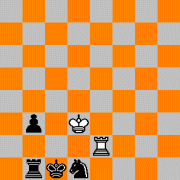 30.cxb5 cxb5 31.g3 Rc8 32.f4 hxg3+ 33.hxg3 gxf4 34.gxf4 Rc3 35.Re3 Rc1 36.Ne4
Bxe4 37.Rxe4 Rb1 38.Re3 Nb6 39.f5 Nc4 40.Rc3 Rb2+ 41.Kg3 Nd2 42.fxe6 Ne4+
43.Kh3 fxe6 44.Re3 Kc6 45.Bxe6 Ng5+ 46.Kg4 Nxe6 47.Kf5 Kd5 48.Rd3+ Nd4+
49.Kf6 Rf2+ 50.Ke7 Kxe5 51.Rc3 Ke4 52.Rc5 Rc2 53.Rh5 Rc4 54.Rh4+ Kd3 55.Rh3+
Kd2 56.Rh2+ Ne2 57.Kd6 Rxb4 58.Kc5 Rb1 59.Rh8 b4 60.Rd8+ Kc2 61.Re8 Nc3
62.Kc4 b3 63.Re3 Nd1 64.Re2+ Kc1 65.Kd3 (see diagram) Rudolf:
"I had 2 seconds left (my opponent some 20), so I didn't even have time
to resign..." 65...b2 66.Rc2 mate.
30.cxb5 cxb5 31.g3 Rc8 32.f4 hxg3+ 33.hxg3 gxf4 34.gxf4 Rc3 35.Re3 Rc1 36.Ne4
Bxe4 37.Rxe4 Rb1 38.Re3 Nb6 39.f5 Nc4 40.Rc3 Rb2+ 41.Kg3 Nd2 42.fxe6 Ne4+
43.Kh3 fxe6 44.Re3 Kc6 45.Bxe6 Ng5+ 46.Kg4 Nxe6 47.Kf5 Kd5 48.Rd3+ Nd4+
49.Kf6 Rf2+ 50.Ke7 Kxe5 51.Rc3 Ke4 52.Rc5 Rc2 53.Rh5 Rc4 54.Rh4+ Kd3 55.Rh3+
Kd2 56.Rh2+ Ne2 57.Kd6 Rxb4 58.Kc5 Rb1 59.Rh8 b4 60.Rd8+ Kc2 61.Re8 Nc3
62.Kc4 b3 63.Re3 Nd1 64.Re2+ Kc1 65.Kd3 (see diagram) Rudolf:
"I had 2 seconds left (my opponent some 20), so I didn't even have time
to resign..." 65...b2 66.Rc2 mate.
243. 17 April 2004:
A genuine underpromotion
René Olthof called my attention to this position he saw in the latest
issue of Schach.
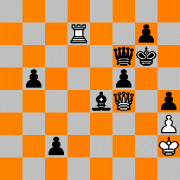 Black to play
Black to play
Baklan - Pham Minh
Cappelle la Grande, 2004
In this totally won position for Black, the computer gives at least
four moves (49...Qb2, Qc3, Kh5 and Kh7) that are better than the one
he played but still, 49...c1B is one of those rare genuine
underpromotions. Its point is to lure the white Queen away and play
Qe5+, but c1Q(R) fails to 50.Rxg7+ followed by 51.Qg5+ etc. and White is
stalemated. Now, White had nothing but 50.Qxc1, and after Qe5+
51.Kg1 Qg3+ 52.Kf1 Bd3+, he resigned.
242. 27 March 2004:
Chess Query Language
As a writer, I'm often asked about themes in my books. I know nothing
about themes, I write stories. They do have themes (I hope, I believe)
but what they are 'really about' is up to the reader. Ten readers, ten
themes. Or fifty - you can see a book in different ways.
I'm reminded of this by Chess Query Language, a
wonderful new tool for chess researchers, almost a magic wand, that
will look for almost anything definable in chess games and compositions.
Take this study that I found with it.
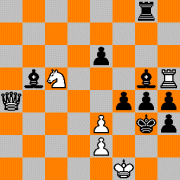 White to play and win
White to play and win
A. Botokanov
3rd Prize, Fizkultura Team Tourney 1992
After 1.Qe4 Bxe2+ 2.Kxe2 f3+ 3.Kf1 h2 White would like to play Ne4+
So: 4.Qe5+ Kh3 5.Qg3+ Kxg3 and he has the same position minus the Queen.
That enables a triumphant solo of the Knight. 6.Ne4+ Kh3 7.Nf2+ Kg3 8.Rxg5
Rxg5 9.Ne4+ Kh3 10.Nxg5+ Kg3 11.Ne4+ Kh3 12.Nf2+ Kg3 13.Nh1+ Kh3 14.Kf2 e5
15.e4 g3+ 16.Kxf3 g2 17.Nf2 mate
What exactly do we see here? Stunning queen sacrifice, smothered mate,
anti-promotion struggle, King switchbacks, Knight's carousel? That
depends on the beholder, but I found this study (and a few hundred
others) when I used CQL to hunt Harold van der Heijden's famous study
database for the 'WCCT7' theme. In that theme, set for the 7th World
Chess Composition Tournament, White actively or passively rids himself
of a piece, returns to a position with only that piece missing, and
wins. Here, 4.Qe5+ Kh3 5.Qg3+ Kxg3 repeats the position without the Qe4.
That square was needed as an entrance for the Knight.
With ChessBase, it is not possible to search for
such abstract themes. But just one amazingly simple line in a .cql script
defines the WCCT7-theme:
:relation (:missingpiececount A 1)
The :relation tag tells CQL to look for studies and games in which more
or less identical positions occur - how identical is defined by other
tags, in this case :missingpiececount. 'A' stands for 'any white piece', and
'1' says that one such piece should be missing. When you run the script
on a database, CQL extracts a sub-database in which all studies and games
meet the given definition.
In fact, it was precisely for this missing-piece
theme that Chess Query Language was developed about a year ago, by the
study composer Gady Costeff and Lewis Stiller, whose second great
contribution to chess this is - the first was his 6-men
tablebase-research in which he discovered, among others, the famous win
in
255 moves with R+B vs. 2N. His proud domain name is www.rbnn.com
Another aim of Chess Query Language was to be a tool for testing the
originality of studies. It enabled me to finally discover whether a combination
I once saw in a dream (see
Dream combination)
had ever happened in reality.
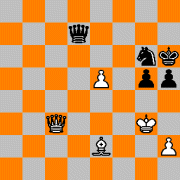 Black to play
Black to play
1...Qh3+ 2.Kxh3 Nf4+ 3.Kg3 Nxe2+ and Nxc3 and wins.
Very simple, but could I have seen this before?
With ChessBase, you can only search for fixed coordinates and their
mirrors but with CQL, I found two studies which had anticipated my
combination, the first in 1954.
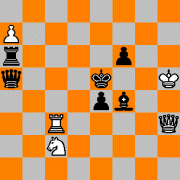 White to play and win
White to play and win
P. Okonkowski
Schach, 1954
1.Rc6 Rxc6 and now my dream: 2.Qf5+ Kxf5 3.Nd4+ Ke5
4.Nxc6+ Kd5 5.Nxa5 and White wins.
CQL is also the answer to the old problem of Study Classification. The
Van der Heijden database has no theme classification,
among other things because assigning themes is, as in literature, a
matter of personal taste - and newly created or defined themes would
require the whole database to be classified again.
It is much better to define an interpretation
first, and only then to look for the studies and games that fit it.
Take my beloved Unguarded Guard - a linepiece checks,
and a piece interposes on an unguarded square. It happens in many
games and studies, but it was never recognized as a theme in itself.
It was impossible to define it in any broad sense with ChessBase, but a
few amazingly simple CQL-lines find all Unguarded Guards in one
sweep.
:wtm
:check
:movefrom [QRBNP]
:moveto .d4
:attackcount A Ad4 0
:shift
:flipcolor
This says White is to play and is in check, and will move any piece but
the King to the empty square d4, which he attacks zero times after that.
The little :shift tag, which almost singlehandedly makes CQL so powerful,
changes d4 into a token square - the specified events may take place on any
square. Finally, :flipcolor makes sure examples with reversed colors
are also found. A :moveto ?d4 tag could be added to limit the search to
cases where the interposed piece is actually captured.
Limiting my search further to interposing Queens, I found
this Unguarded Guard that escaped my attention at the time.
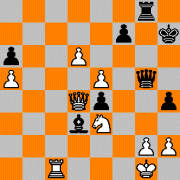 White to play
White to play
Topalov - Judit Polgar
Novgorod 1996
43.Rc7 An unguarded guard is the justification of this sharp move.
43...Rb8 44.Rxf7+ Kg8 45.e6 Qxe3+ 46.Qxe3 Rb1+ 47.Qc1 Clearing e3 to
prevent mate. Of course she had seen that, but perhaps not that after
47...Rxc1+ 48.Kf2, the ending is lost, e.g. 48...Rf1+ 49.Ke3 Rxf7
50.d7! In the game there followed 48...Rc6 49.Rd7 Bb5
50.Ke3 Rc2 51.Rc7 Re2+ 52.Kf4 Rf2+ 53.Kxe4 Re2+ 54.Kf5 Rf2+ 55.Ke5 Re2+
56.Kf6 Rf2+ 57.Ke7 Re2 58.d7 Bxd7 59.Kxd7 Rd2+ 60.Ke8 and Black resigned.
Although it was developed to be used with the Van der Heijden database,
which has 58801 studies, CQL can just as well be used with games, and
with much larger databases. But as it needs (and creates) PGN-files, I had
to convert my 1.9 million game-database to PGN. I held my breath, but
in just over 20 minutes, my computer managed a 1.3 Gb file,
which behaves tidily. Complicated CQL-searches in such a large database
may take hours, but it pays to be stupid here, and search too broadly
first. It only took 15 minutes to extract a 4000-game sub-database with
at least one underpromotion, and searching that instead of the mainbase,
will make any search for themes involving an underpromotion, almost 500
times faster.
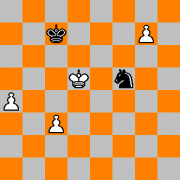 White to play
White to play
Zurakhov - Koblentz
Tbilisi 1956
57.g8N Kb6 58.Kc4 Ne3+ 59.Kb3 Nd5 60.c4 Nc7 61.Nf6 Ne6 62.Ne4 Nc7
63.Nf2 Ne6 64.Nd3 Nd4+ 65.Kc3 Ne2+ 66.Kb4 Nd4 67.c5+ Ka6 68.Kc4 Nf5
69.Kd5 Kb7 70.Nb4 Ne3+ 71.Kd4 Nf5+ 72.Kc4 Ne3+ 73.Kb5 Kc7 74.a5 Nf5
75.Nd5+ Kb7 76.c6+ Ka7 77.c7 Kb7 78.a6+ Ka7 79.c8N+ Kb8 80.Kb6
and Black resigned.
This is one in only 5 games with two serious Knight-promotions.
57.g8N is the only winning move, and also a rare non-checking Knight-promotion.
79.c8N is not the only winning move, but in human terms: the best
move.
As Costeff says, you have to be a little computer-savvy to use CQL - in
fact, it's the most wonderful user-hostile program I've ever seen. The
FAQ on Stiller's site starts with the question: Why is the manual so
difficult to understand. (Answer: We're sorry about that! The manual
is very terse.) (PS 6 April: The (online) manual is far better now.)
It is. There is one line, about the
:not tag, which every time I look at it, ties a knot in my brain.
If :not is specified, the position matches if and only if,
were the :not not specified, the position would not match
But with a little perseverance, even a rookie user like me is not dependent
anymore on what others liked and published. I can do something that was not
possible before: probe primary sources - all the games and all the studies.
Thank you, Chess Query Language, for showing me this Zwickmühle.
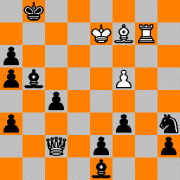 White to play and win
White to play and win
A. Kuznetsov
L'Italia Scacchistica 1974
1.Qe4 Bb4+ 2.Kd8 e1Q 3.Qa8+ Kxa8 4.Bd5+ Kb8 5.Rb7+ Ka8 6.Rxb5+ Ka7
7.Rb7+ Ka8 8.Rxb4+ Ka7 9.Rb7+ Ka8 10.Rb1+ Ka7 11. Rxe1 Ng1 12.Rb1 h1Q
13.Rb7+ Ka8 14.Rh7+ Kb8 15.Rxh1 f2 16.Rh7 f1Q 17.Rb7+ Ka8 18.Rb1+ Ka7
19.Rxf1 and White has captured three Queens with the Zwickmühle, and wins.
You can download Chess Query Language
for free. It comes with that manual and several sample .cql scripts. It is
a command line-program, but the Czech study composer Emil Vlasák offers
VisualCQL, a little
utility for a bit more comfort in a Windows environment.
PS 2 April: Joachim Wintzer sent me the following
game, played last Saturday in the German Bundesliga, asking whether it
might be a world record.
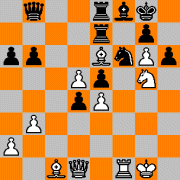 Gurevich - Schmaltz, Bundesliga, 27 March 2004
Gurevich - Schmaltz, Bundesliga, 27 March 2004
1.c4 Nf6 2.Nc3 c5 3.g3 e6 4.Nf3 b6 5.Bg2 Bb7 6.O-O Be7 7.Re1 d6 8.e4 a6
9.d4 cxd4 10.Nxd4 Qc7 11.Be3 O-O 12.Rc1 Re8 13.g4 Bf8 14.g5 Nfd7 15.f4
Nc6 16.Nf3 Rac8 17.h4 Qb8 18. b3 Nc5 19. h5 Nb4
20.g6 Nbd3 21.Ng5 fxg6 22.hxg6 h6 23.Rf1 Nxc1 24.Bxc1 Rc7 25.Bh3
Rce7 26.f5 d5 27.Bf4 e5 28.Bc1 d4 29.Nd5 Bxd5 30.cxd5 Nd7 31.f6 Nxf6
32.Be6+ (see diagram) 32...Rxe6
33.Nxe6 Rxe6 34.dxe6 Qe8
35.Rxf6 gxf6 36.Qh5 Qxe6 37.Kf1 Qd7 38.Bxh6 Bxh6 39.Qxh6 Qg7 40.Qh5 Qh8
41.Qg4 Qh1+ 42.Kf2 Qh2+ 43.Kf3 Qh1+ 44.Kf2 Kg7 45.Qd7+ Kxg6 46.Qe8+ Kg5
47.Qg8+ Kf4 48.Qg3+ Kxe4 49.Qg6+ Kd5 50.Qf7+ Kc5 51.Qxf6 Qh2+ 52.Ke1 Qg1+
53.Kd2 Qe3+ 54.Kd1 d3 55.b4+ Kxb4 56.a3+ Ka5 and White resigned.
Four exchange sacrifices in one game - that can indeed hardly
be surpassed. But was it ever equalled? Chess Query Language is perfect
for this kind of thing. With just a few lines of script, I found
14 cases in my 1,9 million game database. So it is extremely rare, although
I only looked for active sacrifices. (In Gurevich - Schmalz, the first one was
passive.)
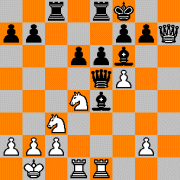 Zelcic - Neverov, Ohrid 2001
Zelcic - Neverov, Ohrid 2001
1.e4 c5 2.Nf3 d6 3.d4 cxd4 4.Qxd4 Nc6 5.Bb5 Bd7 6.Bxc6 Bxc6 7.Nc3 Nf6
8.Bg5 e6 9.O-O-O Be7 10.Qd3 O-O 11.Nd4 Qa5 12.f4 Rac8 13.Kb1 Rfe8 14.f5
Qe5 15.Rhe1 Qxh2 16.Rh1 Qe5 17.Qh3 Bxe4 18.Bxf6 Bxf6 19.Qxh7+ Kf8 20.Rhe1
(see diagram) 20...Rxc3 21.bxc3 exf5 22.g4 fxg4
23.Rxe4 Qxe4 24.Nf5 g6 25.Nh6 Qc4 26.Qg8+ Ke7
27.Re1+ Be5 28.Rxe5+ dxe5 29.Qg7 Qf1+ 30.Kb2 Qf6
31.Ng8+ Rxg8 32.Qxg8 Qb6+ 33.Ka3 g3 34.Qh8
Qd6+ 35.Kb3 g2 36.Qh4+ Qf6 37.Qb4+ Ke8 and White resigned.
241. 25 March 2004:
Rude resignations
In tennis, players will applaud brilliant shots by the opponent. In chess,
such gallant behavior is practically nonexistant. In item 238 of this Diary,
I praised IM Sipke Ernst for allowing Carlsen's beautiful epaulette mate.
Today, Martin van Essen sent me two examples from one (the 4th) round in
the Amber tournament where top players did not applaud their
opponent's brilliant play by allowing their nice mates.
 Svidler - Vallejo, Amber Rapid, Monaco 20 March 2004
Svidler - Vallejo, Amber Rapid, Monaco 20 March 2004
1.e4 c5 2.Nf3 d6 3. d4 cxd4 4. Nxd4 Nf6 5.Nc3 a6 6.f3 e5 7.Nb3
Be6 8.Be3 Be7 9.Qd2 O-O 10.O-O-O Nbd7 11.g4 b5 12.g5 b4 13.Ne2 Ne8
14.Kb1 a5 15.Nbc1 a4 16.f4 exf4 17.Bxf4 Nc5 18.Bg2 b3 19.cxb3 axb3 20.a3 d5
21.Nd4 Nd6 22.exd5 Bg4 23.Rde1 Qd7 24.Qb4 Bf5+ 25.Ka1 Rfb8 26.Qxc5 Nc4
27.d6 Rxa3+ 28.Qxa3 Nxa3 29.dxe7 Nc2+ 30.Nxc2 Qa4+ (see diagram)
and White resigned, instead of letting Black play 31.Na3 Qxa3+
32.bxa3 b2+ 33.Ka2 b1Q mate.
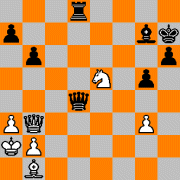 Topalov - Bareev, Amber Rapid, Monaco 20 March 2004
Topalov - Bareev, Amber Rapid, Monaco 20 March 2004
1.e4 e6 2.d4 d5 3.Nc3 Nf6 4.Bg5 dxe4 5.Nxe4 Be7 6.Bxf6 Bxf6 7.Nf3 O-O
8.Qd2 Nd7 9.O-O-O Be7 10.Bd3 b6 11.h4 Bb7 12.c3 c5 13.Neg5 h6
14.Bh7+ Kh8 15.Bc2 Qc7 16.Qd3 Nf6 17.Ne5 Bd6 18.Rde1 cxd4 19.Ng4 Ba6 20.
Qxa6 Nxg4 21.Qd3 Bf4+ 22. Kb1 g6 23. g3 Be5 24. h5 Nxf2 25. Qf3 Nxh1 26. hxg6
fxg6 27. Qxh1 Bg7 28.Nxe6 Qd6 29.Qb7 Rg8 30.Nf4 Rae8 31.Rxe8 Rxe8 32.a3 g5
33.Ng6+ Kg8 34.Qa6 Qd5 35.c4 Qh1+ 36.Ka2 d3 37.Bxd3 Qc6 38.c5 Qxc5 39.
Qa4 Rd8 40.Qb3+ Kh7 41.Ne7+ Kh8 42.Ng6+ Kh7 43.Bb1 Qd4 44.Ne5+
(see diagram) and Black resigned when he should have continued with
44...Kh8 45.Nf7+ Kg8 46.Nxh6++ Kh8 47.Qg8+ Rxg8 48.Nf7 mate.
Among top players, only Short does this occasionally.
It should be chess etiquette at all levels.
PS 18 June: Dan Heisman sent me an interesting note to this item.
He remembers his old chess coach Donald Byrne, "well-known for his
gentlemanly behavior", telling him the story of his loss to Fischer in
their celebrated 'Game of the Century' in 1956.
Later, Donald Byrne was sometimes criticized for playing
on too long in that game. But it was actually the opposite, as he told Heisman
35 years ago.
"First of all, you have to remember that in 1956 no one
knew that Bobby Fischer was going to become Bobby Fischer! He was just
a very promising 13-year-old kid who played a great game against me. When it
got to the position where I was lost, I asked some of the other competitors
if it might be a nice thing to let the kid mate me, as a kind of tribute to
the fine game he played. They said, ‘Sure, why not?’ and so I did."
© Tim Krabbé, 2004
Previous |
Current
Top |
Main chess page |
Main page |
Contact me |
 This is the image on the "First day of issue" envelope at the occasion of the Candidates Tournament in Curaçao, 1962. Not only is Black at the bottom, the board's orientation is wrong as well. Note that the diagram cannot have been mirrored unintentionally; Knights never face right in diagrams.
This is the image on the "First day of issue" envelope at the occasion of the Candidates Tournament in Curaçao, 1962. Not only is Black at the bottom, the board's orientation is wrong as well. Note that the diagram cannot have been mirrored unintentionally; Knights never face right in diagrams.
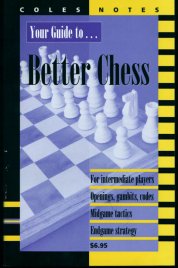
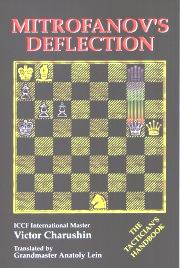
 My collection of chessboards with a dark square in the right hand corner is too large to show, but I especially like this cartoon from the Dutch popular science magazine KIJK. The guy on the left says: "I took care of a toilet for you, so you don't have to go to the john all the time," - but I like the chess clock he brought even better.
My collection of chessboards with a dark square in the right hand corner is too large to show, but I especially like this cartoon from the Dutch popular science magazine KIJK. The guy on the left says: "I took care of a toilet for you, so you don't have to go to the john all the time," - but I like the chess clock he brought even better.
 Cecile Oud - Hendrik Oud, Droomzicht, Sims 2
Cecile Oud - Hendrik Oud, Droomzicht, Sims 2
 Steve Wrinn sent me his favourite King-on-the-wrong square. It's the photo IBM released of dr. C.J. Tan, the non-playing captain of the Deep Blue team that beat Kasparov, proudly posing next to a chessboard - here on the cover of Inside Chess, 9 June 1997.
Steve Wrinn sent me his favourite King-on-the-wrong square. It's the photo IBM released of dr. C.J. Tan, the non-playing captain of the Deep Blue team that beat Kasparov, proudly posing next to a chessboard - here on the cover of Inside Chess, 9 June 1997.
 255. 10 August 2004:
The eternal recurrences of Alois Johandl (1931 - 2004)
255. 10 August 2004:
The eternal recurrences of Alois Johandl (1931 - 2004)
 his "other passion outside chess", his partner Belén - the Spanish form of
Bethlehem. He dedicates his problem to her, and names the theme after her,
wondering if ever before a chess theme has been named after a loved one.
his "other passion outside chess", his partner Belén - the Spanish form of
Bethlehem. He dedicates his problem to her, and names the theme after her,
wondering if ever before a chess theme has been named after a loved one.
 We're telling our own fortunes all the time - if only we knew how.
We're telling our own fortunes all the time - if only we knew how.

 The Bond-movie From Russia with Love (1963) opens with the famous
chess scene. In Venice, the Czech Kronsteen plays in the "International
Grandmasters Championship Final" against the Canadian MacAdams. The score
is 11½ - 11½, suggesting a last game in a World Championship match. In
the position of the diagram, Kronsteen, a lighted cigarette in his hand,
plays Nxe5+, looking MacAdams straight in the eyes. He says: "Check," puts
the cigarette between his lips and pushes his clock button. The move is
also executed on a giant demonstration board in the playing hall, by a
valet who calls out: "Knight takes Bishop." A waiter steps onto the stage,
bringing both players a glass of water. Kronsteen takes a sip; a gesture
by the waiter makes him realize this is a message. Through the bottom of
the glass he reads on the napkin underneath: YOU ARE REQUESTED AT ONCE.
He pats his lips with the napkin, then tears it. MacAdams, looking
worried, plays Kh7 - this move too, is announced and played on the
demonstration board. Kronsteen gives him a stare again and with a
triumphant smirk plays Qe4+, this time without saying "check". The valet
at the demonstration board calls out: "Queen to King 4." MacAdams startles,
spectators rise. MacAdams topples over his King and says: "Congratulations
sir, that was a brilliant coup." Amidst applause, Kronsteen leaves the
board and the hall, ignoring congratulatory hands strectched out to him.
He walks to a ship in the harbour, where it turns out he works for the
terrorist organisation SPECTRE.
The Bond-movie From Russia with Love (1963) opens with the famous
chess scene. In Venice, the Czech Kronsteen plays in the "International
Grandmasters Championship Final" against the Canadian MacAdams. The score
is 11½ - 11½, suggesting a last game in a World Championship match. In
the position of the diagram, Kronsteen, a lighted cigarette in his hand,
plays Nxe5+, looking MacAdams straight in the eyes. He says: "Check," puts
the cigarette between his lips and pushes his clock button. The move is
also executed on a giant demonstration board in the playing hall, by a
valet who calls out: "Knight takes Bishop." A waiter steps onto the stage,
bringing both players a glass of water. Kronsteen takes a sip; a gesture
by the waiter makes him realize this is a message. Through the bottom of
the glass he reads on the napkin underneath: YOU ARE REQUESTED AT ONCE.
He pats his lips with the napkin, then tears it. MacAdams, looking
worried, plays Kh7 - this move too, is announced and played on the
demonstration board. Kronsteen gives him a stare again and with a
triumphant smirk plays Qe4+, this time without saying "check". The valet
at the demonstration board calls out: "Queen to King 4." MacAdams startles,
spectators rise. MacAdams topples over his King and says: "Congratulations
sir, that was a brilliant coup." Amidst applause, Kronsteen leaves the
board and the hall, ignoring congratulatory hands strectched out to him.
He walks to a ship in the harbour, where it turns out he works for the
terrorist organisation SPECTRE.


 "The rhythm of Makruk Thai is somewhat restrained," writes Gralla, "so it is
very close to that great
historic version of chess, the Arabic Shatranj, that has blossomed during
the first Golden Age Of Chess at the Bagdad of the Caliphs, starting out at
the beginning of the 9th century. With the most inspiring consequence that,
by playing Makruk Thai, you get a real feeling for what it has been like
when such legendary personalities of the history of chess, the great
teachers and authors as-Suli and al-Lajlaj, have been waging their epic
battles while all the beautiful ladies of the harems - ladies who have been
great players too in many cases - were seducingly looking on ... promising
the rewards of paradise for the winner... That's why Makruk Thai is
chess history that is still alive and going on
strong: by playing a match of that variant from Southeast Asia you are
experiencing a kind of Kon-Tiki-effect on the chess-board."
"The rhythm of Makruk Thai is somewhat restrained," writes Gralla, "so it is
very close to that great
historic version of chess, the Arabic Shatranj, that has blossomed during
the first Golden Age Of Chess at the Bagdad of the Caliphs, starting out at
the beginning of the 9th century. With the most inspiring consequence that,
by playing Makruk Thai, you get a real feeling for what it has been like
when such legendary personalities of the history of chess, the great
teachers and authors as-Suli and al-Lajlaj, have been waging their epic
battles while all the beautiful ladies of the harems - ladies who have been
great players too in many cases - were seducingly looking on ... promising
the rewards of paradise for the winner... That's why Makruk Thai is
chess history that is still alive and going on
strong: by playing a match of that variant from Southeast Asia you are
experiencing a kind of Kon-Tiki-effect on the chess-board."
